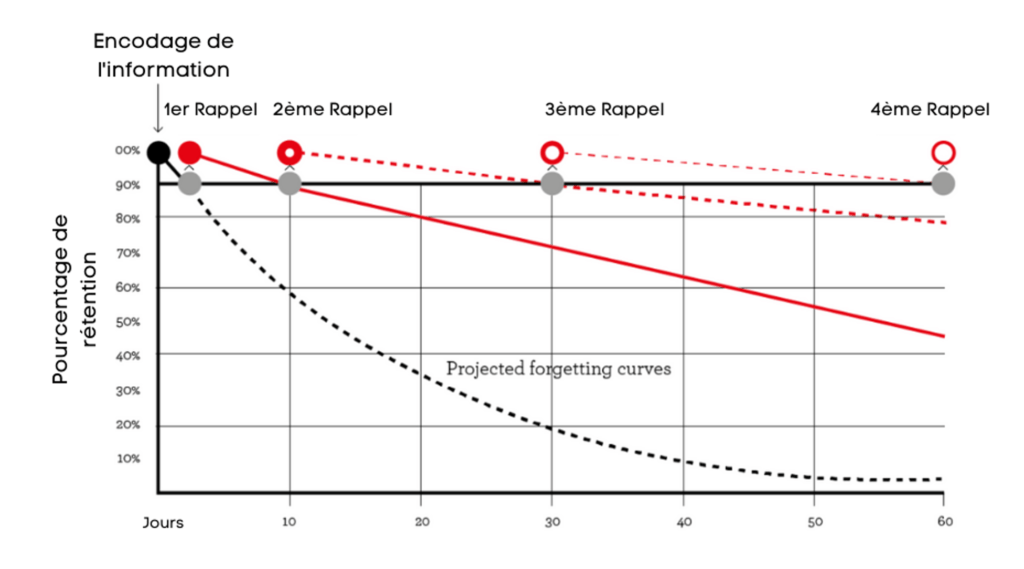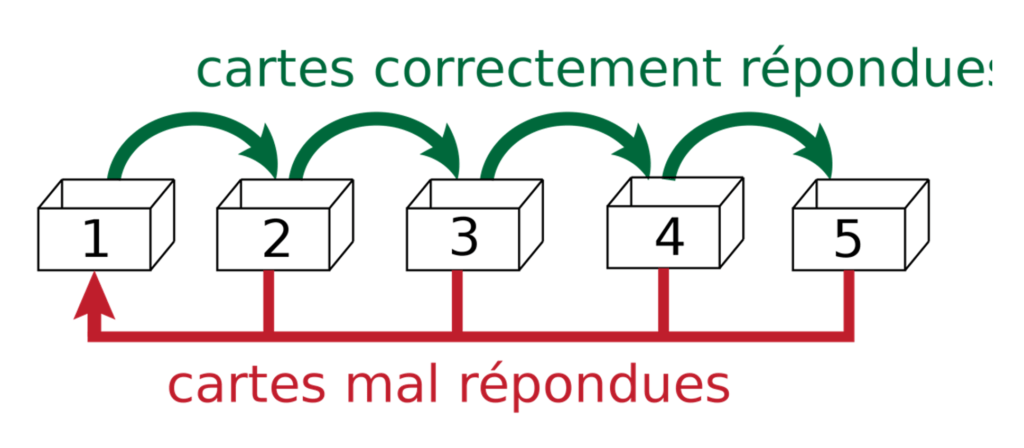Spaced review and learning reinforcement
Whether it’s the day before an important exam or for a crucial report to superiors, we have all tried to read and re-read our notes in the hope of retaining the information and remembering it when needed.
However, this method is not only boring, but also inefficient. As basic neuroscience research has shown, trying to retain a large amount of information in a short period of time even goes against the normal functioning of our brain.
Thanks to progress in cognitive sciences, new techniques now consider how our brain works to help us learn better.
1. Memory & Neuroscience: How does our brain remember?
Memory is the process of encoding, storing, retrieving information and knowledge. It’s essential for the development and survival of all living species. Without memory, we would not be able to learn or perform simple everyday tasks. However, memory is not just a box where we store information, it’s a complex system that is part of our brain. Neuroscience has shown that there are several types of memory, including:
- Short-term memory: this allows the brain to remember a small amount of information for a short period of time. This is the type of memory used when trying to remember a series of numbers such as a telephone number or a code. This memory is very limited in terms of amount of information stored, and retention duration.
- Long-term memory: unlike the first type, it allows the storage of information over a long period of time (sometimes up to years). Long-term memory can be divided into two different types: explicit memory (which is conscious and includes information and concepts that we remember, such as historical dates) and implicit memory (which is unconscious and represents physical memory, such as the action of driving or riding a bicycle).
In the case of retention, the explicit long-term memory is used. Following a sensory perception, an event is created, and this is encoded in our memory. This encoding is done thanks to synaptic plasticity, which is the capacity of the nervous system to form and unform connections between neurons. These connections called synapses can be strengthened or weakened depending on when and how often they were activated in the past. Active connections tend to get stronger, while those that are not used get weaker and may eventually disappear completely[1].
Thus, the initial creation of the synapse between the neurons storing a particular piece of information is not sufficient to guarantee the permanence of the information, which risks disappearing if the synapse is not reinforced. Hence the importance of repetition, the effect of which has been proven, as far as spacing is concerned, by the work of Ebbinghaus.
2. The Ebbinghaus forgetting curve
Hermann Ebbinghaus was a German psychologist who dedicated his career to the modelling of memory and more particularly to the forgetting curve, which defines how quickly a piece of information learned will be forgotten. It can be seen below that after a few days the retention percentage declines considerably:

During this work, Ebbinghaus found a way to slow down this forgetting curve thanks to reminders at increasingly longer intervals. These reminders act like vaccine reminders to call up information and thus strengthen the synapses between the neurons that store this information. We can see the effect of these booster shots on the percentage of retention over the days [2]:

Les travaux d’Ebbinghaus ont été démontrés dans de nombreuses études modernes qui ont expérimenté sur des populations types l’effet de l’espacement des révisions et en les comparant à d’autres groupes qui ont suivi d’autres méthodes (bachotage ou aucune révision)Ebbinghaus’ work has been demonstrated in many modern studies that have tested the effect of spaced revisions on typical populations and compared them to other groups that followed other methods (cramming or no revision)[3].
3. Using technology to consolidate learning
Grâce aux découvertes d’Ebbinghaus, nombreux sont ceux qui ont mis en place des systèmes de révision avec un planning et des flash-cards à retenir. Sebastian Leitner, un autre scientifique allemand a simplifiéThanks to Ebbinghaus’ findings, many people have set up revision systems with a schedule and flash cards to remember. Sebastian Leitner, another German scientist, has simplified the spaced revision as much as possible with his system of boxes: the first box contains the cards to be revised daily, the second box contains the cards to be revised every other day and so on, with the last box containing the cards to be revised once a month. A simple system, but one that has been proven in numerous studies [4].

Technological evolutions allowed the digitalization of different spaced revision systems and anchoring tools have been developed, including Anki [5] and Supermemo [6]. The former is an intelligent flash-card management tool, while with the latter, the Supermemo algorithm will find the optimal time to revise. A few minutes of learning per day is enough to memories effectively, this algorithm considers the modelling of the forgetting curve presented above, the history of correct and incorrect revisions as well as the difficulty of the content to be retained.
On Domoscio’s side, Lock guarantees the sustainable maintenance of skills thanks to its learning reinforcement in the vocational education, while Spark’s Spaced Repetition module is adapted to the educational sector to consolidate knowledge and ensure long-term memorization. These two products, by considering the forgetting curve as well as the cognitive load of the learner and his memorization capacity, offer a personalized content at an adequate date.
Conclusion
Advances in cognitive science and the rise of new technologies have improved the possibilities in learning by proposing more effective techniques and solutions for long-term retention of skills.
Several tools exist such as Anki, Supermemo or Domoscio which use the system of spaced revisions to propose revisions at specific dates and make the memory work before the notion is forgotten.
Of course, other techniques exist for long-term learning reinforcement, such as Active Recall (testing oneself after learning new information) or Micro-doing.
Sources
[1] The University of Queensland Australia (23 juillet 2018). How are memories formed?https://qbi.uq.edu.au/brain-basics/memory/how-are-memories-formed
[2] Fs.blog, The Spacing Effect: How to Improve Learning and Maximize Retention https://fs.blog/spacing-effect/
[3] David P. Ausubel and Mohammed Youssef (6 juillet 2010). The Effect of Spaced Repetition on Meaningful Retention, The Journal of General Psychology, https://www.tandfonline.com/doi/abs/10.1080/00221309.1965.9711263?journalCode=vgen20
[4] Zaidatun Tasir, Jamalludin Harun, Nurul Farhana Jumaat (December 2015). Learning english vocabulary using web-based leitner box with social network, research gatehttps://www.researchgate.net/publication/289500617_Learning_english_vocabulary_using_web-based_leitner_box_with_social_network
[5] Anki, about Anki https://apps.ankiweb.net/
[6] Super memo, Learn with super memo https://www.supermemo.com/en
Latest news
Our latest articles about the topics: learning, science and Domoscio's news.